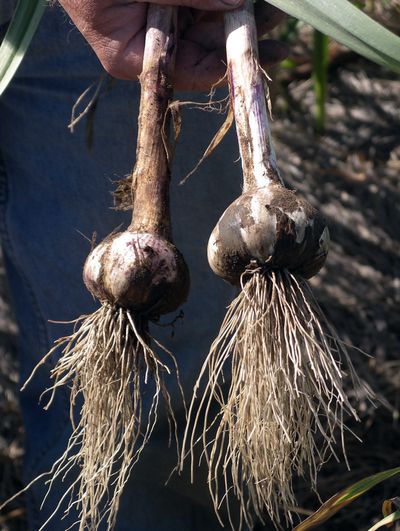Garlic makes for an easy project to end the season

One of my last gardening projects each fall is to plant garlic. There is something about breaking the heads apart and setting each clove in the ground that is very satisfying. I look at it as a celebration of the year to come.
Garlic is very easy to grow. It needs to be planted at the right time in the fall in reasonably fertile soil with adequate water and full sun. In our area, garlic needs to planted between late September and the end of October. Like tulips, daffodils and other spring bulbs, it will grow roots until the ground freezes at the end of November into December and then go dormant until spring. It can be planted in the spring but without time to grow roots, the bulbs will be small.
Garlic does best in a loose, loamy soil that drains quickly and is high in organic matter. In a home garden, garlic thrives in raised beds filled with soil blended with well-aged manure, shredded leaves or compost.
There are two main types of garlic; softneck and hardneck. Softneck garlics have larger heads, keep for several months and are often used in garlic braids because of their soft, pliable stem. Hardneck garlics have a stiff stem, are generally smaller, have a stronger flavor but don’t keep more than two to three months in storage. Both types can be purchased at good garden centers or online. Grocery store garlic can be planted but may not be reliably hardy here.
Select heads with the largest cloves you can. Store the entire bulb in a cool, dry place until you are ready to plant. Gently break the heads apart leaving the papery wrappers in place. Plant only the largest cloves and keep the rest for the kitchen. Size matters here.
An easy way to plant garlic is to first cover the bed with four to six inches of shredded leaves, pine needles or clean, loose straw (no hay – too many grass seeds). Then clear furrows six inches apart in the mulch and down three inches into the soil. Plant the garlic, pointed end up and cover with soil. Firm the soil over the cloves and water well to settle them in. Mulching the bed this way will keep the soil warm and you won’t have to come back and cover the bed later.
Once the danger of hard freezes has passed in the spring, pull the mulch back to expose the emerging garlic. Apply a good vegetable fertilizer or some blood and bone meal to give the plants a boost. Fertilize again in late May when the heads start forming. Garlic is ready to harvest when about half the leaves have turned yellow
Want to learn more about growing garlic? Check out “Growing Great Garlic,” by Ron Engeland, Filaree Productions, 1991. This is the definitive book on growing garlic organically. Although written more for the commercial small-scale grower, it goes into great detail on the types of garlic, growing requirements, crop management, and harvesting and curing.